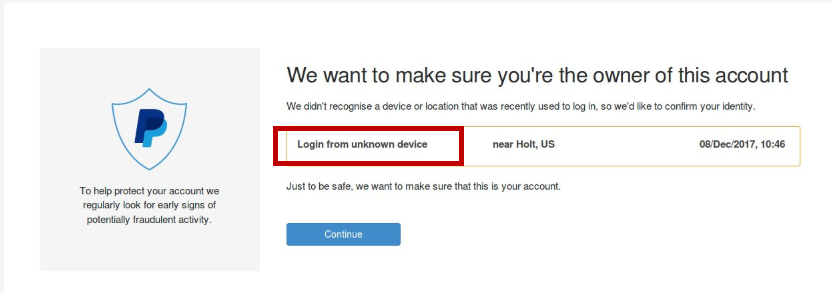Login From Unknown Device
“Login from unknown device” is a commonly used email scam tactic that sees to get its victim to provide some sensitive details about themselves. The premise of the “Login from unknown device” scam is that someone has entered your account without permission. The user receives an email notifying them about the intruder and telling them that the targeted account has been locked up for security reasons. The user is then asked to confirm their identity by providing certain personal details.

to deceive the user
In this post, we will tell you about one of the most recent scam campaigns that use this premise. The scam in question targets PayPal accounts and tries to gain access to them as well as acquire some additional info about the victims. This PayPal scam first got noticed during the second half of December last year and it seems to be mostly targeting users in South America. According to the information we currently have, the scam campaign is still around, claiming more and more victims.
How does the scam work?
As we already mentioned, this type of “Login from unknown device” scams seek to get the user tricked into believing that one of their online accounts has been breached by a hacker. In the current case, the account in question is the victim’s PayPal account. The user receives an email from the scammers that’s disguised as a legitimate message from PayPal. Inside it, it is stated that hackers have tried to enter the account and, in order to stop them, PayPal has blocked the targeted account. The victim is then told to follow a link to confirm that they are the owner of the attacked profile by providing some personal details. Of course, the link redirects to a phishing page that looks nearly identical to a legitimate PayPal page but is actually hosted by the scammers. Once the user fills in the required details (username, password, credit card numbers, etc.), this info gets into the hands of the scammers, who can then use it for all kinds of criminal activities.
The specific thing about this particular “Login from unknown device” PayPal scam is that the crooks try to get their hands on more than just your PayPal login details. In addition to your PayPal username and password, the scammers also want you to provide them with your full name, address, date of birth, phone number, credit/debit card details, and some information about the bank account you’ve connected to your PayPal. In the end, you are even told to provide your email account’s password and username.
Recognizing the scam
This PayPal scam seems to be orchestrated and prepared with greater attention to detail and it may be a bit difficult for less experienced users to initially spot it. Still, if you are watchful enough, you should be able to notice some of the red flags related to different elements of the scam.
The email and its sender
The first giveaway sign is related to the email message and the address that has send it to you. If you pay attention to the sender’s email and compare it with PayPal’s official email address, you will notice that they differ.
Secondly, the URL of the link provided in the message (the one you are required to follow) will not be the same as the actual URL of PayPal. To check the link’s URL, right-click on the link and select Copy link address. Then paste copied link in a notepad file to see the actual address you would get redirected to if you click.
Thirdly, scam emails such as this one oftentimes have grammatical errors in their text. This particular scam message doesn’t have too many of them, but there are still some that you may notice. A legitimate message from PayPal wouldn’t have any errors in its text.
The phishing page
This scam’s phishing page is designed to look almost identical to an actual PayPal page. However, the things you are required to provide as information are a huge red flag. PayPal shouldn’t have information about your email login details, which is something you are told to provide.
Other red flags
Usually, most legitimate websites don’t send such messages to their users. They have other ways of securing the accounts of their customers in case of an attempt for unauthorized access. This means that it is pretty much guaranteed that, if you ever receive an email asking you to follow a link in order to confirm that you are the owner of one of your online accounts, you have become the target of an online scam.

Leave a Reply